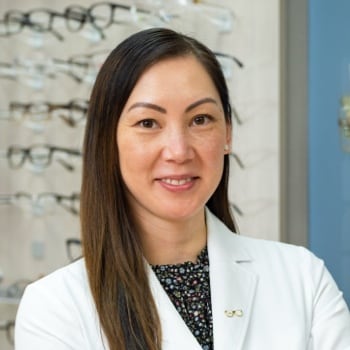When it comes to vision problems, there are 2 that come up often: myopia and hyperopia. But what exactly is the difference between these?
Myopia is also known as nearsightedness, which is best described as faraway objects appearing blurry while nearby objects remain clear. However, hyperopia is kind of like the opposite—faraway objects are clear, while your eyes struggle to focus on nearby things. Fortunately, both of these have treatment options, typically through the use of eyeglasses, contact lenses, or corrective laser eye surgery.
What Is Myopia?
Myopia, also known as nearsightedness, is a common form of refractive error that occurs when the eye grows longer than it is wide or when the cornea is shaped incorrectly. This leads to light refracting into the eye improperly, causing the development of blurry images. This condition typically develops in early childhood or adolescence before stabilizing around the age of 18–20.
In a healthy eye, light is refracted towards a singular focal point on the retina, allowing your eye to build a clear image of what it’s looking at. However, myopia causes this focal point to be in front of the retina rather than on it, causing light rays to scatter and refract improperly.
What Are the Symptoms of Myopia?
Because myopia causes light rays to scatter in the eye and refract to the wrong point, it can lead to several vision problems. These potential problems can include:
- Blurry vision
- Eye strain
- Eye fatigue
- Headaches
- Constant squinting
Myopia is considered a progressive condition, meaning that as the condition continues to develop, these symptoms tend to increase in severity while the eye continues growing. While the direct cause of myopia is unknown, genetics contribute to a person’s likelihood of developing it. This means that if one or both of your parents suffer from nearsightedness, you’re much more likely to develop it yourself.
What Is Hyperopia?
Hyperopia, also known as farsightedness, is kind of like the opposite of myopia—rather than nearby objects being clear, hyperopia causes faraway objects to be clearer while nearby objects are blurrier. This is caused by the eye growing wider than it is long or the cornea having too steep a curve.
Rather than light rays focusing on the retina, hyperopia causes the focal point to be behind the retina. This leads to difficulty seeing nearby objects, while faraway objects remain clear.
What Are the Symptoms of Hyperopia?
Typically, the symptoms of hyperopia include:
- Difficulty focusing on nearby objects
- Blurry vision
- Headaches
- Eye strain
- Aching or burning eyes when working on nearby things
- Irritability or nervousness after sustained nearby concentration
This condition causes a great deal of difficulty when trying to focus on nearby objects, which can lead to the eyes straining themselves trying to build a clear image of your surroundings. Most people with hyperopia are born with this condition, though in some cases, it may not cause vision problems until later in life.
While it’s unknown what exactly causes this condition, genetics can play a part—you’re more likely to have hyperopia if someone in your family has it.
How Are Vision Problems Treated?
Fortunately, since myopia and hyperopia are common forms of refractive error, there are many options available to treat these conditions. Typically, these include:
- Prescription eyeglasses
- Contact lenses
- Corrective surgery, like LASIK or PRK
With new developments in the field of optometry, more specialized options are being developed every year. One of these options is the use of specialty contact lenses, like orthokeratology, or ortho-k, lenses. These are special lenses worn overnight that temporarily reshape the eye. When removed during the day, they help correct your natural refractive error.
Another popular choice is the use of atropine eye drops. These temporarily dilate the pupil and affect the muscles that help the eye’s lens focus. When used to treat myopia, they can help the eye avoid straining itself, which may help reduce myopia progression.
Where to Get Help for Myopia & Hyperopia
When it comes to correcting refractive errors, the first step is to schedule a comprehensive eye exam. Due to how common myopia and hyperopia are, treatment is readily accessible at most optometric offices across the country. While these conditions aren’t considered reversible, they are highly treatable through vision correction.
Your optometrist will thoroughly examine your eyes and diagnose what may be causing your blurry vision, allowing you to work together to choose which method of treatment will help your vision.At Eyes on Plainville, we know how important your vision is to your everyday life, and we’re here to help. Schedule an appointment with us today and take the first step toward getting help for your myopia or hyperopia.





